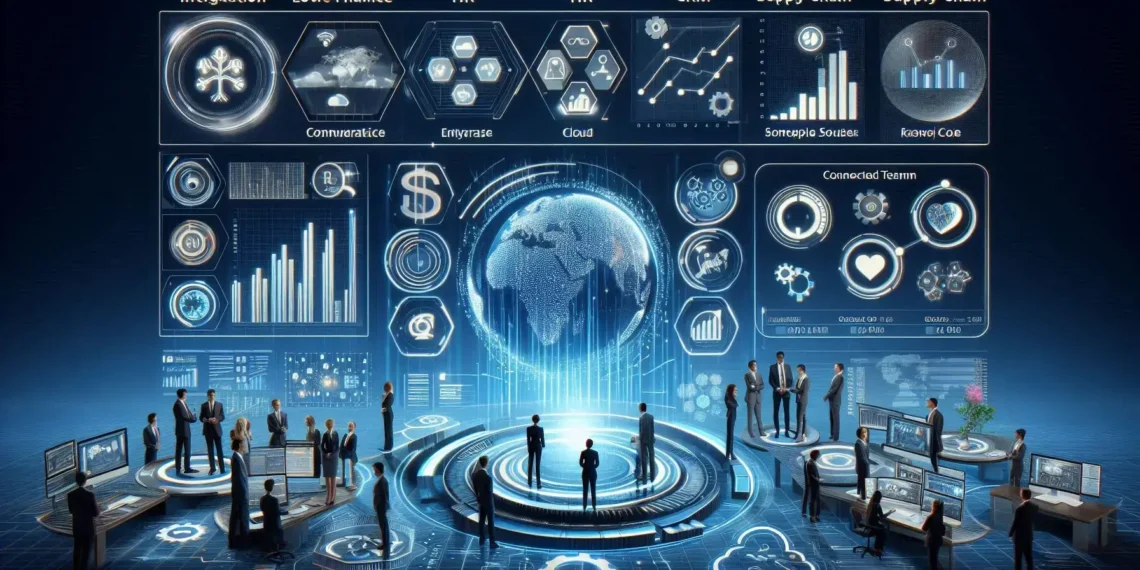Enterprise Resource Planning (ERP) remains a critical backbone for modern companies. But in 2025, it’s not just about integrating finance, HR, or CRM: today’s ERP systems lean heavily into cloud-native architectures, AI-driven analytics, and low-code customization.
-
Real-time intelligence: Many modern ERPs use embedded analytics or predictive modules to forecast demand, cash flow, or resource constraints.
-
Scalability and flexibility: Cloud ERP platforms now offer modular pricing, microservices, and on-demand computing meaning companies can scale up (or down) more efficiently than before.
-
User experience: With distributed teams and remote work, ERP systems are emphasizing mobile-first design, in-browser use, and intuitive low-code workflows.
-
Integration: Modern ERPs are built to plug into other SaaS systems (like collaboration tools, BI, e-commerce) via APIs or pre-built connectors.
In short, ERP is no longer just a “system of record”: it’s becoming a system of insight and system of action.
Key Features to Look for in ERP Systems Today
When evaluating ERP tools, consider:
-
AI & Predictive Modules – Does the ERP offer demand forecasting, anomaly detection, or predictive cash-flow modeling?
-
Cloud vs. On-Premises – Does your business benefit more from cloud flexibility or from keeping systems in-house?
-
Low-Code / No-Code Customization – Can non-technical users adapt workflows and reports?
-
Collaboration / Mobile Access – How well does the ERP work on mobile devices or collaborate across teams?
-
Analytics & Reporting – Are there built-in dashboards, KPIs, and real-time data visualizations?
-
Cost / Total Cost of Ownership (TCO) – Subscription pricing, implementation costs, maintenance, and integrations all matter.
-
Vendor Ecosystem – How strong is the partner network, marketplace, or third-party extension support?
Top 10 ERP Solutions: Free & Paid
Here is an updated ranking of the top ERP tools reflecting new trends, market shifts, and added value.
ERP Solution |
Ideal Use-Case |
Why It Stands Out |
|---|---|---|
1. Odoo |
Versatile small to mid-sized businesses |
Odoo remains a powerful open-source ERP. Its modular design lets companies pick only what they need — CRM, inventory, MRP, accounting — and now includes AI-enhanced dashboards and smart automation for low-code workflow building. |
2. Microsoft Dynamics 365 (Finance & Supply Chain) |
Enterprises already in Microsoft ecosystem |
Dynamics 365 now embraces hybrid deployment, with stronger cloud-native features, built-in predictive finance insights, and seamless integration with Microsoft Teams, Power BI, and Azure. |
3. Oracle NetSuite |
Fast-growing mid-size to large businesses on cloud |
NetSuite is now more AI-aware: built-in demand planning, cash-flow predictions, and embedded BI make it a top choice. The SuiteAnalytics module has gotten smarter, giving real-time business intelligence. |
4. SAP S/4HANA Cloud |
Global corporations needing scalability |
SAP’s flagship ERP leverages in-memory computing for real-time data. In 2025, S/4HANA Cloud has added advanced AI planning for supply chain disruption, predictive maintenance, and tighter integration with the SAP Business Technology Platform. |
5. Workday |
HR-heavy or people-centric enterprises |
Workday continues to dominate for organizations that prioritize human capital management. Its cloud-first architecture, smart reports, and planning modules (e.g., for workforce, finance) remain cutting-edge. |
6. Acumatica |
Growing businesses requiring flexibility |
Acumatica’s cloud ERP allows unlimited users, strong mobile access, and flexible deployment. In 2025, it’s gaining ground thanks to improved built-in analytics, real-time dashboards, and AI-based cash-flow suggestions. |
7. ERPNext |
Open-source lovers and SMBs |
ERPNext remains a favorite in the open-source world. It offers a fully integrated suite — accounting, CRM, manufacturing — and now includes a machine-learning module for forecasting and smart automations. |
8. Sage Intacct |
Financially driven mid-market companies |
Sage Intacct remains a finance-first cloud ERP. The 2025 version boasts smarter financial consolidation tools, predictive revenue management, and deeper reporting layered with embedded analytics. |
9. Plex |
Manufacturing firms with shop-floor needs |
Plex (cloud-based) specializes in manufacturing: it offers real-time shop-floor control, inventory traceability, quality management, and now AI-powered predictive maintenance to reduce downtime. |
10. Infor CloudSuite (Industrial / Financial) |
Industry-specific enterprises |
Infor’s CloudSuite continues to be tailored to industries (manufacturing, healthcare, etc.). Recently, Infor added microservices-based deployment, low-code design for workflows, and predictive analytics for operations. |
Expert-Style Insights & Analysis
AI Is Not Just a Buzzword Anymore
The most advanced ERP systems now offer predictive planning and anomaly detection. Instead of just showing historical data, they can forecast inventory shortages, cash flow gaps, or maintenance needs. For example, a mid-size manufacturer using Plex could now leverage AI to predict machine failures before they happen dramatically reducing downtime and costs.
Cloud ERP vs. On-Premises — What Is Right for You?
-
Cloud-first: Tools like Netsuite, Acumatica, S/4HANA Cloud, and Workday favor scalability, lower upfront costs, and continuous updates. Ideal for growing companies or those who don’t want to manage servers.
-
On-Premises / Hybrid: Solutions like Dynamics 365 (if deployed on-prem or hybrid) or ERPNext (self-hosted) give you more control and potentially lower long-term hosting costs useful if data sovereignty or latency is a concern.
Open-Source vs Proprietary
-
Open-Source (Odoo, ERPNext): Offers unmatched flexibility and cost control, but requires more technical know-how or a partner for full implementation.
-
Proprietary (NetSuite, SAP, Workday): Better out-of-the-box support, strong vendor ecosystems, and more polished UX. However, these usually come with higher subscription fees and less freedom to customize deeply.
Total Cost of Ownership (TCO)
Don’t just think about license fees. When comparing ERPs, also consider:
-
Implementation consulting costs
-
Data migration
-
Ongoing maintenance and upgrades
-
Training for users
-
Integration with existing software
A smaller company may save short-term with open-source but spend more on support; a large business may justify a premium cloud ERP thanks to productivity gains and built-in intelligence.
Common Questions (People Also Ask)
Q: What is the best free or open-source ERP software for 2025?
A: For open-source, Odoo and ERPNext are among the best. Odoo provides a modular structure and extensive app marketplace, while ERPNext is simple, fully integrated, and now supports forecasting via AI.
Q: Are cloud ERP systems more cost-effective than traditional ones?
A: Often yes, for growing companies. Cloud ERP reduces upfront infrastructure costs, provides automatic updates, and scales with your business. However, long-term subscription costs can add up, and hybrid or on-prem may be cheaper in steady-state for large enterprises.
Q: How long does ERP implementation take in 2025?
A: Implementation time depends on customization. A small business using low-code modules of Odoo or Acumatica can often launch in 3–6 months. A large-scale SAP S/4HANA or NetSuite deployment might take 9–18 months due to integrations, data migration, and process redesign.
Q: Can I use AI features in ERP without a data science team?
A: Yes many modern ERPs embed AI and predictive models behind simple user interfaces. You don’t need to build algorithms yourself; the system handles forecasting, anomaly detection, or maintenance prediction through pre-built modules.
Conclusion
ERP software in 2025 is evolving fast, it’s no longer just about centralizing data, but about predicting, automating, and optimizing business operations.
-
Odoo and ERPNext remain strong open-source contenders.
-
Cloud giants like NetSuite, SAP, and Workday are pushing AI-first capabilities.
-
Flexible, modern ERP like Acumatica and Plex blend industry-specific power with scalable cloud architecture.
Your best choice depends not just on feature lists, but on long-term strategy: how you want to grow, how much control you need, and how smart you want your system to become.









